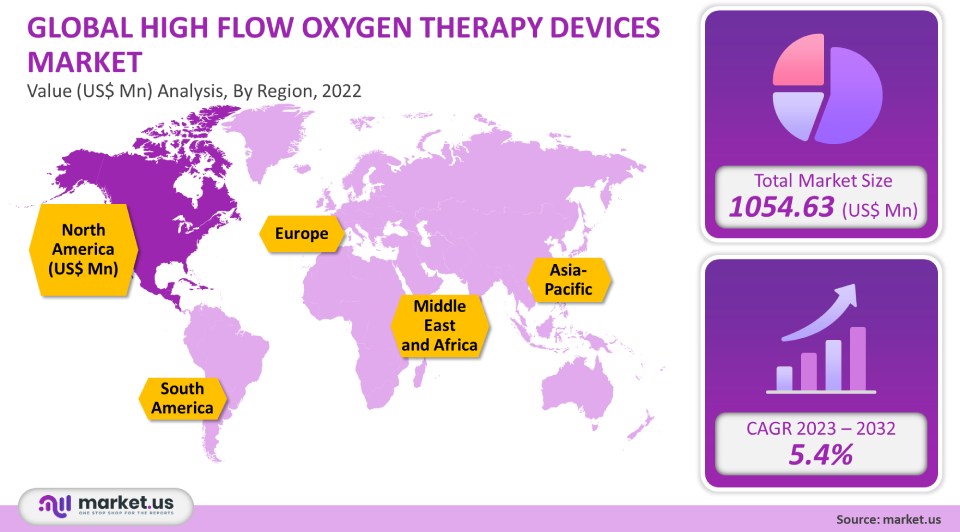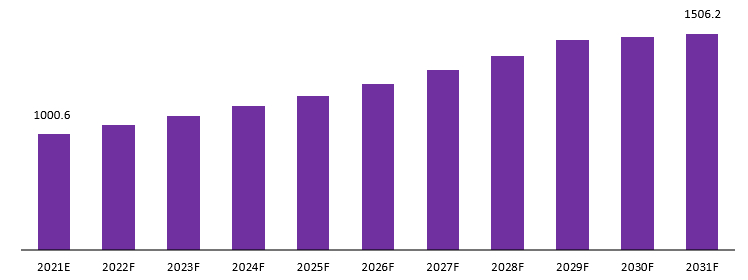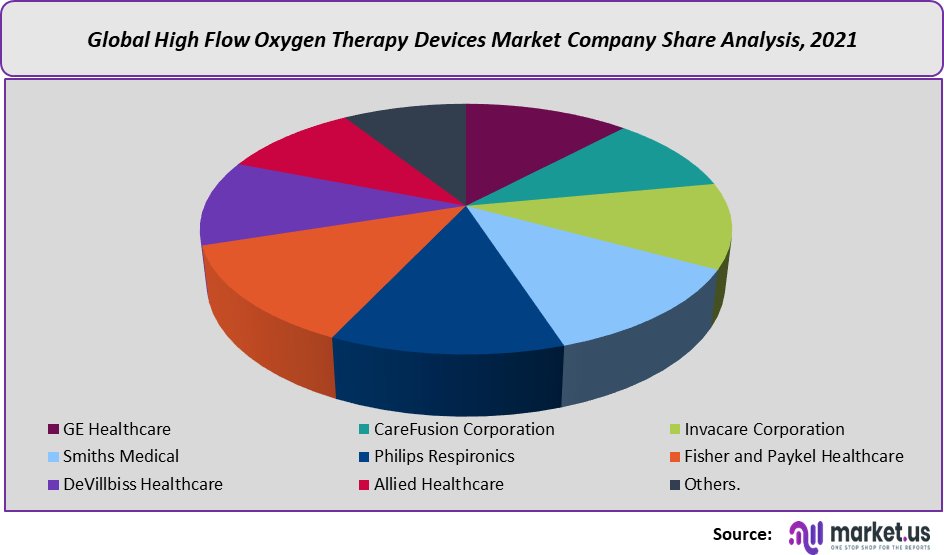Global High-Flow Oxygen Therapy Devices Market, by Product Type (Oxygen Source Equipment, Oxygen Delivery Devices), and by End Users (Hospital, Clinic, Ambulatory Surgical Center, Home Healthcare) and by Region and Companies - Industry Segment Outlook, Market Assessment, Competition Scenario, Trends and Forecast 2022-2032
- Published date: Feb 2022
- Report ID: 84569
- Number of Pages: 270
- Format:
- keyboard_arrow_up
High Flow Oxygen Therapy Devices Market Overview:
The global high-flow oxygen therapy devices market is projected to reach a valuation of USD 1,784.46 Mn by 2032 at a CAGR of 5.4%, from USD 1,054.63 Mn in 2022.
High-Flow Oxygen Therapy (HFOT) devices are designed to provide higher levels of oxygen for patients who need it to enhance their respiratory function. These devices are often used in hospital settings, to help people breathe easier during medical emergencies. The use of HFOT can be life-saving, potentially reducing mortality rates by up to 50%.
High-flow oxygen therapy is a type of mechanical ventilation that is most often used in neonatal intensive care units and comes with a variety of features. Some devices can also measure the concentration of oxygen in a patient’s blood whereas others only measure the concentration of CO2 in a patient’s exhaled breath. High-flow oxygen therapy devices are used to increase the rate of oxygen consumption by the lungs, and thereby provide more oxygen to the blood. It consists of a tube that diverts air from the outside into an air compressor. The air is then heated by either steam or electric heating elements to about 150° Fahrenheit, which causes it to expand. This expansion causes the pressure in the device to be greater than the atmospheric pressure which forces it through a narrow passage. The high-flow system can deliver up to 4 Liters Per Minute (LPM) at pressures as low as 2 psi. A typical adult requires approximately 15 LPM for adequate ventilation. However, this amount may vary depending on age, weight, activity level, etc.

High-flow oxygen therapy aids in breathing support for individuals with:
- Acute heart failure
- Acute Respiratory Distress Syndrome (ARDS)
- Asthma
- Bronchiectasis
- Chest trauma (fractured ribs)
- Exacerbation of Chronic Obstructive Airways Disease (COPD)
- Lung Cancer
- Pneumonia
- Pulmonary Oedema
The components of a high flow oxygen therapy device typically consist of an oxygen cylinder and a regulator. Oxygen cylinder manufacturers list how much flow and what pressure is needed for a device. Hospitals use these devices in order to provide better care to their patients. They are used by doctors as well as nurses when caring for critically ill patients. These devices allow them to monitor vital signs such as blood pressure, heart rate, breathing rates, etc., while providing comfort to a patient. High-flow oxygen therapy devices are mainly utilized in the Asia Pacific and Europe.
A typical High-Flow Nasal Cannula (HFNC) delivers up to 60 L/min, with pressures ranging from 5cm H2O to 15cm H20. It consists of two parts: one section that fits over the nose or mouth, and another that connects to tubing which leads into a patient’s airway. This type of mask can be used in place of Continuous Positive Airway Pressure (CPAP) therapy. HFNCs are most commonly used as rescue therapies when patients fail conventional treatment such as NIV or BiPAP. They may also be used during the weaning-off mechanical ventilation. The main advantage of this method is its ability to deliver large amounts of oxygen at low positive end-expiratory pressure levels without causing significant discomfort. However, it has been found that there is no difference between HFNC and standard noninvasive ventilator support, in terms of mortality rates.
High Flow Oxygen Therapy Devices Market Revenue (USD Mn), 2021–2031:

Market Dynamics:High-Flow Oxygen Therapy (HFOT) devices are now available for home use to increase oxygen levels in the blood. HFOT devices now come with alarms that alert patients when they are breathing too hard or if there is a leak in the mask. Such factors are expected to boost the demand for these products in the coming years.
High-flow oxygen therapy devices have been an excellent way to help patients with asthma, chronic obstructive pulmonary disease, cystic fibrosis, and other respiratory illnesses. HFOTs are a type of medical device that provides a high concentration of oxygen to a patient through a face mask or nasal cannula. Oxygen is not only beneficial in treating infections but can also help with inflammation and pain. Hence, this is expected a significant factor that is expected to boost the economic trajectory of high-flow oxygen therapy devices over the forecast period.
The use of high-flow oxygen therapy devices can lead to longer hospital stays, increase the risk of hospital-acquired infections, and decrease patient safety. The field of high-flow oxygen therapy devices, which is now widely used in the medical profession, has its share of negative aspects. There are now more than one hundred million anesthetics and numerous other types of medical professionals who use such devices, and there is a great demand for them. However, there are also two major problems that lead to lower adoption levels of these devices.
Many patients who have respiratory disease or other ailments may be prescribed high-flow oxygen therapy. The issue with these devices is that the tubing and connections may easily leak, which can lead to contamination in the air supply. This can be a problem for patients who are immunocompromised or have a lowered immune system. It has been shown by some studies that high-flow oxygen therapy devices are not safe for use. One study found that these devices had a 10% incidence of aerotoxic syndrome. When used, they decrease airway resistance, which can cause atelectasis and hypercapnia. The process of breathing with the device on is also known to increase intraocular pressure, which can lead to glaucoma or cataracts. These factors are expected to potentially hamper the market growth of this global industry over the projected timeline.
Increasing evidence has suggested that high-flow oxygen therapy may help decrease the risk of death, hospitalization, and chronic lung disease in patients with COPD.
In the United States, COPD is a major public health concern. This increase can largely be attributed to smoking cessation rates failing to keep pace with population growth. As such, there are currently approximately 16 million smokers living with this debilitating condition. These factors are expected to create lucrative opportunities for both existing as well as emerging players in this target market.

Competitive Landscapes:
This research report on the global high-flow oxygen therapy devices market includes major company profiles such as
- GE Healthcare
- CareFusion Corporation
- Invacare Corporation
- Smiths Medical
- Philips Respironics
- Fisher and Paykel Healthcare
- DeVillbiss Healthcare
- Allied Healthcare
- Tecno-Gaz Industries
- Teleflex
- MAQUET Medical Systems
- Others.
Segmentation:
Segmentation of Global High Flow Oxygen Therapy Devices Market is Based on – Product Type, End-User, and Region
Based on Product Type:
- Oxygen Source Equipment
- Oxygen Delivery Devices
Based on End User:
- Hospitals & Clinics
- Ambulatory Surgical Centers
- Home Healthcare
Based on Regions:
- North America
- Europe
- Asia Pacific
- South America
- MEA
For the High Flow Oxygen Therapy Devices Market research study, the following years have been considered to estimate the market size:
Attribute Report Details Historical Years
2016-2020
Base Year
2021
Estimated Year
2022
Short Term Projection Year
2028
Projected Year
2023
Long Term Projection Year
2032
Report Coverage
Competitive Landscape, Revenue analysis, Company Share Analysis, Manufacturers Analysis, Volume by Manufacturers, Key Segments, Key company analysis, Market Trends, Distribution Channel, Market Dynamics, COVID-19 Impact Analysis, strategy for existing players to grab maximum market share, and more.
Regional Scope
North America, Europe, Asia-Pacific, South America, Middle East & Africa
Country Scope
United States, Canada and Mexico, Germany, France, UK, Russia and Italy, China, Japan, Korea, India and Southeast Asia, Brazil, Argentina, Colombia etc.Saudi Arabia, UAE, Egypt, Nigeria and South Africa
![High Flow Oxygen Therapy Devices Market High Flow Oxygen Therapy Devices Market]() High Flow Oxygen Therapy Devices MarketPublished date: Feb 2022add_shopping_cartBuy Now get_appDownload Sample
High Flow Oxygen Therapy Devices MarketPublished date: Feb 2022add_shopping_cartBuy Now get_appDownload Sample - GE Healthcare
- CareFusion Corporation
- Invacare Corporation
- Smiths Medical
- Philips Respironics
- Fisher and Paykel Healthcare
- DeVillbiss Healthcare
- Allied Healthcare
- Tecno-Gaz Industries
- Teleflex
- MAQUET Medical Systems
- Others.
- settingsSettings
Our Clients
|
Single User
$5,999
$2,999
USD / per unit
save 50% |
Multi User
$7,999
$3,499
USD / per unit
save 55% |
Corporate User
$12,999
$4,499
USD / per unit
save 65% | |
|---|---|---|---|
| e-Access | |||
| Data Set (Excel) | |||
| Company Profile Library Access | |||
| Interactive Dashboard | |||
| Free Custumization | No | up to 10 hrs work | up to 30 hrs work |
| Accessibility | 1 User | 2-5 User | Unlimited |
| Analyst Support | up to 20 hrs | up to 40 hrs | up to 50 hrs |
| Benefit | Up to 20% off on next purchase | Up to 25% off on next purchase | Up to 30% off on next purchase |
| Buy Now ($ 2,999) | Buy Now ($ 3,499) | Buy Now ($ 4,499) |









